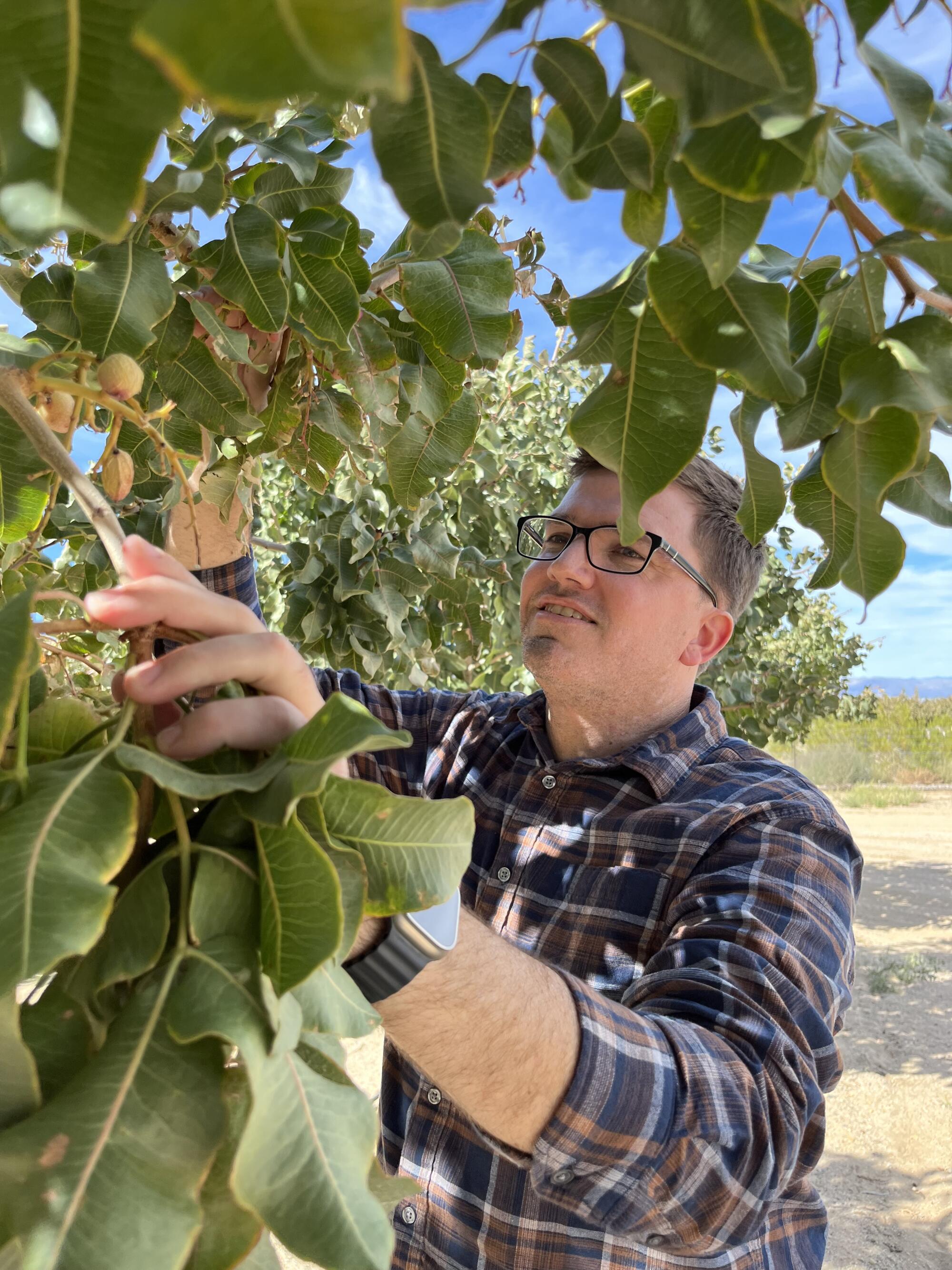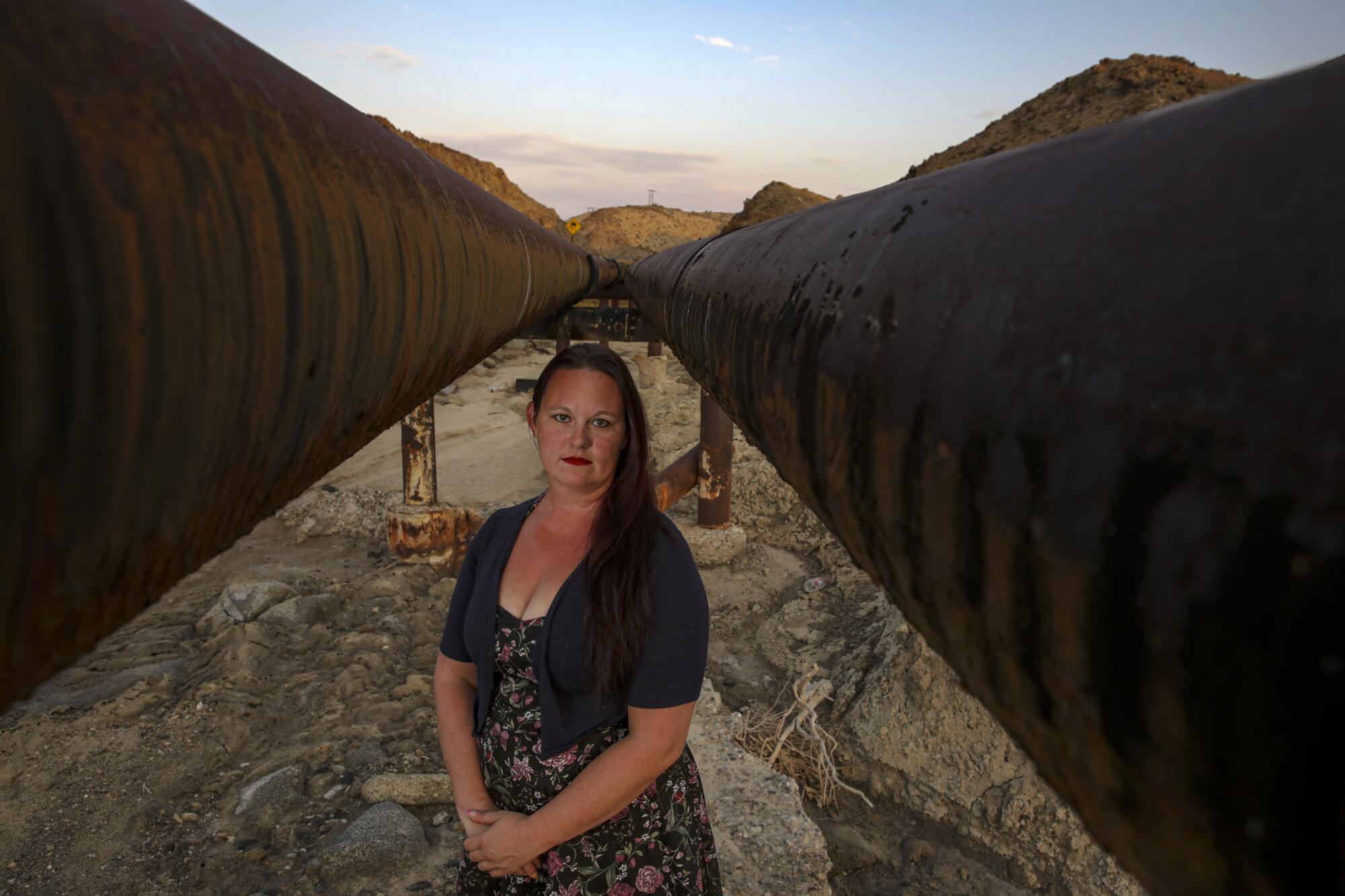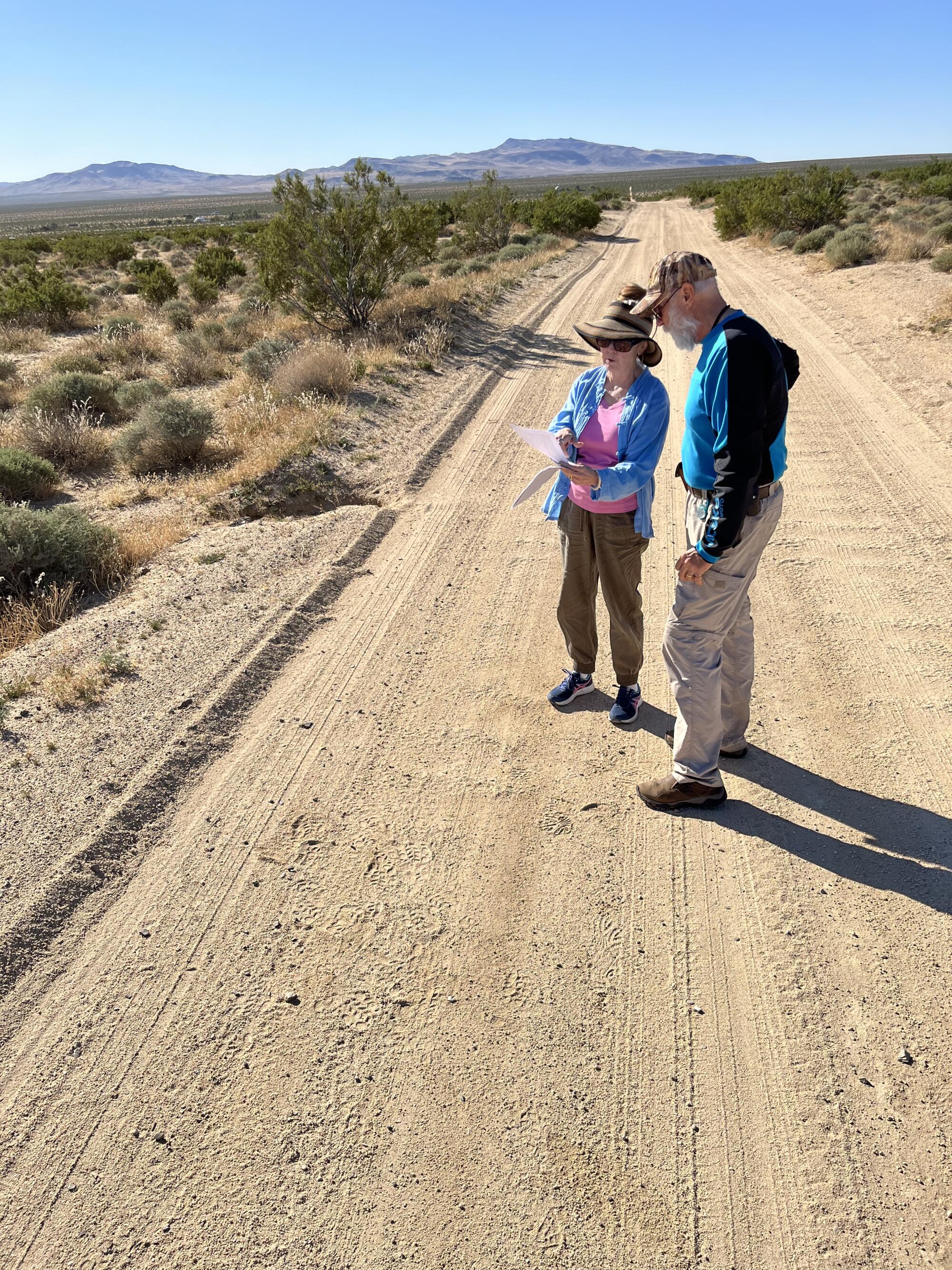After a long time of unrestricted pumping within the rain-starved northwestern nook of the Mojave Desert, the Indian Wells Valley Groundwater Basin Authority has the excellence of managing one of the crucial critically overdrawn aquifers in California.
Now, the area is in an uproar over a proposal that the authority sees as a manner out of its groundwater disaster, one which critics say would give precedence to city customers within the metropolis of Ridgecrest and the adjoining Naval Air Weapons Station China Lake over farmers and mining operations.
It’s a $200-million, 50-mile-long pipeline system that might transfer water from the California Aqueduct in California Metropolis — over arid desert mountains — to a storage tank within the city middle of Ridgecrest.
The federal authorities would pay $150 million of the associated fee, authority officers say, with the remaining $50 million handed on to ratepayers, together with pistachio growers and mining operations just lately saddled with a particular “groundwater replenishment charge” of as much as $6 million a yr.
That doesn’t embrace the possibly formidable prices of buying water to be conveyed by the pipeline, planning, annual operation and upkeep, officers mentioned.
To listen to the authority inform it, the times when landowners may dig a properly in Indian Wells Valley and pump to their coronary heart’s content material, as long as the water was put to a helpful use, are over.
“The farmers and mining firms are submitting lawsuits in opposition to us as a result of their groundwater isn’t free anymore,” mentioned Keith Lemieux, who serves as each Ridgecrest metropolis legal professional and groundwater authority counsel. “However we can not proceed overdrafting the area’s most essential supply of recent water.”
To take action, he mentioned, dangers a possible takeover by state officers. That’s as a result of state regulation requires that native businesses deliver groundwater aquifers into balanced ranges of pumping and recharge.
The quantity of water presently flowing into the valley’s underground basin is 7,650 acre-feet a yr. Annual utilization is about 28,000 acre-feet. Eight wells have gone dry up to now yr, and about 800 are in danger, officers mentioned.
However that is no traditional stop-the-overdraft battle.
The Indian Wells Valley aquifer lies below a degree within the jap Sierra Nevada vary panorama the place the corners of San Bernardino, Kern and Inyo counties meet.

Entrance to the Naval Air Weapons Station China Lake alongside West Inyokern Street in Ridgecrest.
(Los Angeles Instances)
In 2019, the Naval Air Weapons Station China Lake, which generates $36 million in state and native taxes and represents a big portion of the native economic system, mentioned its prime issues embrace encroachment on groundwater, suggesting that shortages of its sole supply of potable water may drive it to close down and transfer away.
“With out the bottom, there’s no Ridgecrest,” Lemieux mentioned. “We’ve got to have extra water.”
Draining the aquifer would additionally sink Ridgecrest’s hopes of a bustling future of latest houses, eating places, and companies for the 5,900 scientists, engineers and contractors employed at China Lake, which is present process about $4 billion price of upgrades prompted by the 6.4. 5.4 and seven.1 magnitude quakes that rocked the world in 2019.
“I don’t see Ridgecrest turning into the following Las Vegas or Victorville, but it surely may benefit from some further improvement,” mentioned Carol Thomas-Keefer, basic supervisor of the groundwater authority.
“Extra importantly,” she mentioned, “the pipeline is an answer to a persistent drawback: Wells are going dry as a result of people are tapping the aquifer’s provide of recent water sooner than it’s being returned to the basin naturally by rain and snowmelt off the Jap Sierra Nevada vary.”
That type of discuss has prompted Searles Valley Minerals, in the neighborhood of Trona, and Mojave Pistachios, a tree nut firm on the west aspect of Ridgecrest, to stand up in a fury, declaring the proposed pipeline is a part of a groundwater sustainability plan that forces them to bear an allegedly unfair and unlawful financial burden that threatens their continued existence.
“It’s a pipe dream — one so weird it’s virtually laughable,” mentioned Amy M. Steinfeld, an legal professional representing Mojave Pistachios, whose 210,000 bushes materialized like a inexperienced oasis a couple of decade in the past throughout 1,600 acres of scorched desert.
“They’ve utterly ignored quite a few options that might meet their targets whereas considerably lowering the monetary prices and environmental impacts,” she mentioned.
Tensions have already flared over an aquifer “replenishment charge” of $2,130 per acre-foot imposed on a choose few customers by the groundwater authority in 2021. That elevated the water prices for Mojave Pistachios and Searles Valley Minerals by as a lot as $6 million per yr.
The China Lake base, one of many largest customers of water within the valley, has federal reserve water rights that make it exempt from the replenishment charge and pipeline prices handed on to ratepayers.

Joshua Nugent, a spokesman for Mojave Pistachios, inspects among the 210,000 pistachio bushes his agricultural firm has planted throughout 1,600 acres close to town of Ridgecrest. The corporate is refusing to pay what it calls “unfair replenishment charges” imposed by the Indian Wells Groundwater Basin Authority which might be primarily pricing it out of its water rights.
(Louis Sahagun / Los Angeles Instances)
“This charge is like saying everybody has a proper to drive a Lamborghini — if they’ll afford one,” gruffed Joshua Nugent, a spokesman for Mojave Pistachios.
Claiming that it deprives them of their water rights and will put them out of enterprise, each Mojave Pistachios and Searles Minerals are defying an order to pay the charges or stop pumping. The water district in Indian Wells Valley can also be being charged however is making its cost below protest.
Their instances, that are being heard in Orange County Superior Court docket to keep away from claims of bias, have the potential to be landmark litigation as new groundwater regulators all through the state contemplate how finest to implement the state Sustainable Groundwater Administration Act of 2014.
The battle has spawned an excellent bit of hysteria in Trona, a withering city of 1,500 residents in a wind-swept bowl hugged by three rugged mountain ranges that depends on groundwater provided by Searles Valley Minerals.
Searles officers say the authority’s resolution to single it out with the hefty replenishment charge, together with proposed fee will increase associated to the pipeline, may push the corporate out of enterprise after greater than 140 years of operation, placing its 700 workers out of labor and turning Trona right into a historic footnote.

July 2021 photograph of neighborhood activist Regina Troglin stands between two rust noticed water pipes, owned by Searles Valley Minerals, touring by Poison Canyon that provides water to Trona.
(Irfan Khan / Los Angeles Instances)
“With no Searles, there’s no Trona,” mentioned Regina Troglin, 35, a resident and freelance architectural designer.
“Simply because Ridgecrest desires to develop doesn’t imply it has the appropriate to kill off Trona,” she mentioned. “If the authority and Ridgecrest had been severe about sustaining groundwater, they’d be pushing for storm water restoration, greywater recycling methods, and garden removals.”
The pipeline plan has additionally sparked challenges from environmentalists and the California Division of Fish and Wildlife.
That’s as a result of it will lower a zigzag path from a place to begin on the Antelope Valley-East Kern Water Company feeder pipeline in California Metropolis by historic habitat for wildlife together with mountain lions, state and federally threatened desert tortoises and state threatened Mojave floor squirrels, chubby rodents with huge eyes that advocates prefer to say resemble “glad little Buddhas.”
A selected concern is hybridization with round-tailed squirrels, which use disturbed areas as inhabitants enlargement alternatives and have been shifting westward from the Barstow space.

Ileene Anderson, a senior scientist on the Middle for Organic Range, and Edward LaRue, a biologist on the Desert Tortoise Council, survey habitat for the state and federally threatened desert tortoise and state threatened Mojave floor squirrel that they fear can be destroyed by a proposed 50-mile-long pipeline Ridgecrest officers say is required to maintain an overdrawn underground water basin.
(Louis Sahagun / Los Angeles Instances)
Excessive on a bluff overlooking Indian Wells Valley, Ileene Anderson, a senior scientist with the Middle for Organic Range, gazed out over the bone-dry desert valley born of seismic upheavals, flash floods, drought and warmth.
“It’ll be a tricky battle, however we’re not going away — there are a whole lot of unanswered questions concerning the pipeline’s impacts on wildlife and vegetation,” she mentioned. “We’re not satisfied that importation of water over lengthy distances is even sustainable over the long run below local weather change eventualities for California.”
That debate took a shocking flip in August when tropical storm Hilary triggered flash floods that washed out county roads within the proposed website of three booster pump stations essential to push water within the pipeline over the El Paso Mountains.
However backers of the pipeline mentioned flood dangers go together with the territory, particularly in arid mountainous areas, and may very well be resolved by mitigation.
“We’ll simply put the pipeline a bit deeper within the floor,” mentioned Don Strand, Ridgecrest metropolis supervisor.
A extra urgent query, he mentioned, is whether or not proponents can safe funding for the controversial proposal.
“If we are able to’t afford the pipeline, we now have an enormous drawback,” he mentioned.
#Dry #California #metropolis #plans #construct #50mile #water #pipeline
